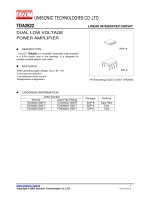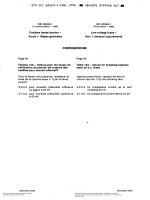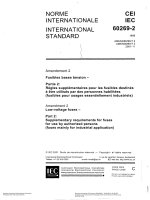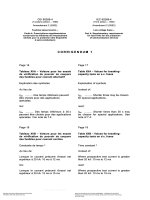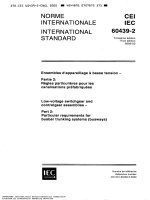Low voltage CMOS log companding analog design
Bạn đang xem bản rút gọn của tài liệu. Xem và tải ngay bản đầy đủ của tài liệu tại đây (19.93 MB, 208 trang )
LOW-VOLTAGE CMOS LOG COMPANDING ANALOG DESIGN
THE KLUWER INTERNATIONAL SERIES IN ENGINEERING AND
COMPUTER SCIENCE
ANALOG CIRCUITS AND SIGNAL PROCESSING
Consulting Editor: Mohammed Ismail. Ohio State University
Related Titles:
SYSTEMATIC DESIGN OF ANALOG IP BLOCKS
Vandenbussche and Gielen
ISBN: 1-4020-7471-9
SYSTEMATIC DESIGN OF ANALOG IP BLOCKS
Cheung & Luong
ISBN: 1-4020-7466-2
LOW-VOLTAGE CMOS LOG COMPANDING ANALOG DESIGN
Serra-Graells, Rueda & Huertas
ISBN: 1-4020-7445-X
CIRCUIT DESIGN FOR WIRELESS COMMUNICATIONS
Pun, Franca & Leme
ISBN: 1-4020-7415-8
DESIGN OF LOW-PHASE CMOS FRACTIONAL-N SYNTHESIZERS
DeMuer & Steyaert
ISBN: 1-4020-7387-9
MODULAR LOW-POWER, HIGH SPEED CMOS ANALOG-TO-DIGITAL CONVERTER
FOR EMBEDDED SYSTEMS
Lin, Kemna & Hosticka
ISBN: 1-4020-7380-1
DESIGN CRITERIA FOR LOW DISTORTION IN FEEDBACK OPAMP CIRCUITE
Hernes & Saether
ISBN: 1-4020-7356-9
CIRCUIT TECHNIQUES FOR LOW-VOLTAGE AND HIGH-SPEED A/D CONVERTERS
Walteri
ISBN: 1-4020-7244-9
DESIGN OF HIGH-PERFORMANCE CMOS VOLTAGE CONTROLLED OSCILLATORS
Dai and Harjani
ISBN: 1-4020-7238-4
CMOS CIRCUIT DESIGN FOR RF SENSORS
Gudnason and Bruun
ISBN: 1-4020-7127-2
ARCHITECTURES FOR RF FREQUENCY SYNTHESIZERS
Vaucher
ISBN: 1-4020-7120-5
THE PIEZOJUNCTION EFFECT IN SILICON INTEGRATED CIRCUITS AND SENSORS
Fruett and Meijer
ISBN: 1-4020-7053-5
CMOS CURRENT AMPLIFIERS; SPEED VERSUS NONLINEARITY
Koli and Halonen
ISBN: 1-4020-7045-4
MULTI-STANDARD CMOS WIRELESS RECEIVERS
Li and Ismail
ISBN: 1-4020-7032-2
A DESIGN AND SYNTHESIS ENVIRONMENT FOR ANALOG INTEGRATED CIRCUITS
Van der Plas, Gielen and Sansen
ISBN: 0-7923-7697-8
RF CMOS POWER AMPLIFIERS: THEORY, DESIGN AND IMPLEMENTATION
Hella and Ismail
ISBN: 0-7923-7628-5
DATA CONVERTERS FOR WIRELESS STANDARDS
C. Shi and M. Ismail
ISBN: 0-7923-7623-4
DIRECT CONVERSION RECEIVERS IN WIDE-BAND SYSTEMS
A. Parssinen
ISBN: 0-7923-7607-2
AUTOMATIC CALIBRATION OF MODULATED FREQUENCY SYNTHESIZERS
D. McMahill
ISBN: 0-7923-7589-0
MODEL ENGINEERING IN MIXED-SIGNAL CIRCUIT DESIGN
S. Huss
ISBN: 0-7923-7598-X
ANALOG DESIGN FOR CMOS VLSI SYSTEMS
F. Maloberti
ISBN: 0-7923-7550-5
LOW-VOLTAGE CMOS
LOG COMPANDING ANALOG
DESIGN
by
Francisco Serra-Graells
Instituto de Microelectrónica de Barcelona, IMB-CNM
Adoración Rueda
Instituto de Microelectrónica de Sevilla-CNM
and
José L. Huertas
Instituto de Microelectrónica de Sevilla-CNM
KLUWER ACADEMIC PUBLISHERS
NEW YORK, BOSTON, DORDRECHT, LONDON, MOSCOW
eBook ISBN:
Print ISBN:
0-306-48721-7
1-4020-7445-X
©2004 Springer Science + Business Media, Inc.
Print ©2003 Kluwer Academic Publishers
Dordrecht
All rights reserved
No part of this eBook may be reproduced or transmitted in any form or by any means, electronic,
mechanical, recording, or otherwise, without written consent from the Publisher
Created in the United States of America
Visit Springer's eBookstore at:
and the Springer Global Website Online at:
Contents
List of Figures
List of Tables
Acknowledgments
ix
xix
xxi
1. INTRODUCTION
1
Low-Power Applications and CMOS Technologies
State-of-the-Art Low-Power Analog Design
2
Instantaneous Companding Theory
3
4
CMOS Subthreshold Companding Proposal
Structure of this Book
5
1
1
3
5
11
12
2. MOSFET MODELING FOR COMPANDING
1
Model Requirements for Analytical Design
Large Signal Equations
2
2.1
DC Drain Current
Quasi-Static Capacitances
2.2
Small signal Parameters
3
4
Noise Equations
5
Technology Mismatching Model
Parameter Extraction Procedure
6
23
23
24
24
27
30
34
36
41
3. AMPLIFICATION AND AGC
1
Log Companding Principle
CMOS Generalization
2
Basic Building Blocks
3
General-Purpose Controllable Amplifier Cell
3.1
Low-Impedance Gain Control Voltage Sources
3.2
Full-Wave Rectifiers
3.3
Envelope Filtering
3.4
51
51
53
55
55
6l
65
67
v
vi
LOW-VOLTAGE CMOS LOG COMPANDING ANALOG DESIGN
4
Log Ruler
3.5
3.6
Compression Ratio Scaling
Design Examples
68
70
72
4. FILTERING
1
Log Companding Principle
2
CMOS Generalization
3
Basic Building Blocks
3.1
Saturated CMOS Cells
3.2
Non-Saturated CMOS Cells
Auxiliary Circuitry
3.3
Design Methodology
4
Case Studies
5
5.1
Integrator
5.2
First-Order Low-Pass
5.3
Second-Order Low-Pass
5.4
Second-Order Band-Pass
6
All-MOS Implementations
Design Examples
7
79
79
80
86
88
90
95
98
100
100
102
102
105
110
117
5. PTAT GENERATION
1
Log Companding Principle
CMOS Generalization
2
3
Design Examples
125
125
127
129
6. PULSE DURATION MODULATION
Log Companding Principle
1
CMOS Generalization
2
Design Example
3
137
137
139
141
7. DYNAMIC RANGE
1
CMOS Considerations
1.1
Moderate Inversion distortion
Noise Floor
1.2
Dynamic Range Versus Signal-to-Noise Ratio
2
145
145
146
149
150
8. INDUSTRIAL APPLICATION: HEARING AIDS
1
History and Market
2
Previous CMOS Analog Systems
A True 1V CMOS Log-Domain Analog Hearing-Aid-on3
Chip
3.1
Systern-on-Chip Specifications
157
157
159
160
160
vii
Contents
4
3.2
Full-Custom ASIC Implementation
3.3
Comparative Results
Yield Issues
162
164
168
9. CONCLUSIONS
1
Results
2
Future Work
177
177
179
Appendices
Simulation and Test
1
Numerical Simulation
1.1
SPICE Models
1.2
Numerical Convergence
1.3
Large Signal Frequency Analysis
Technology Mismatching Simulation
1.4
2
Experimental Test Setup
References
183
183
183
183
184
184
185
189
192
List of Figures
1.1
1.2
1.3
1.4
1.5
1.6
1.7
1.8
2.1
2.2
2.3
2.4
2.5
Prediction of Digital supply voltage scaling for ULSI
technologies.
Map of state-of-the-art CMOS low-power analog
continuous-time circuit techniques.
D R comparison between classic (left) and companding (right) processing schemes.
Example of
compression for a
Example of a higher
compression than that
in Figure 1.4
Signal domains for the generalized companding processing.
comparison between linear, quadratic and exponential laws
companding functions F
for
Main inputs and outputs of this book.
Basic nomenclature for NMOS (left) and PMOS
(right) devices.
Normalized drain current versus pinch-off voltage
in forward saturation and
The dashed
lines indicate the asymptotic approximations of Table 2.1.
Simplified transcapacitance MOS model.
Normalized MOS transcapacitances in conduction
(dashed) and forward saturation (solid) for
DC small signal equivalent circuit of the CMOS
transistor.
ix
3
4
6
7
7
9
10
12
25
27
29
31
32
x
LOW-VOLTAGE CMOS LOG COMPANDING ANALOG DESIGN
2.6
2.7
2.8
2.9
2.10
2.11
2.12
2.13
2.14
2.15
3.1
3.2
3.3
3.4
3.5
3.6
Normalized
versus inversion coefficient in forward saturation. Dashed lines indicate the asymptotic approximations of Table 2.1
Relative drain current deviations versus inversion
coefficient for a typical
CMOS process of Figure 2.8 and
at room temperature.
NMOSFET and
deviations versus technology generation at room temperature.
PMOSFET
and
deviations versus technology generation at room temperature.
Analytical model (solid) extracted from experimental unitary curves (dotted), and fitting results for
a
NMOS device.
Analytical model (solid) extracted from typical BSIM3
unitary curves (dashed), and fitting results for a
NMOS device.
Matrix of MOS geometries used in the extraction
procedure for a
CMOS process example.
Resulting
and
after applying the procedure of Table 2.6 to the typical and corner BSIM3
models of the NMOS devices listed in Figure 2.12.
Resulting in weak (transparent) and strong (solid)
inversion after applying Table 2.6 to the typical
BSIM3 models of the NMOS devices listed in Figure 2.12.
Threshold voltage deviations versus MOSFET channel area.
General AGC model using Log amplifiers.
Summary of gain controlling topologies for GD (left)
SD (center) and BD (right) realizations (auxiliary
circuitry in dashed).
Schematic of the GD-SC NMOS cell (auxiliary circuitry in dashed).
Simple active load (left) and classic input impedance
control (right).
New input impedance control (left) and its CCI/IIequivalence (right).
Low-voltage CMOS implementation proposal for
Figure 3.5.
34
39
40
40
43
44
45
46
47
47
52
54
56
57
58
59
List of Figures
3.7
3.8
3.9
3.10
3.11
3.12
3.13
3.14
3.15
3.16
3.17
3.18
3.19
3.20
3.21
3.22
3.23
Analytical (solid) and BSIM3 simulated (dashed)
maximum frequency overshoot versus normalized
compensation.
Low-voltage implementation of the controllable amplifier cell.
Normalized input (dashed) and output (solid) autobiasing values for feedback factors N = 1, 2, 4 and
8.
General low-ohmic model (left) and low-voltage
topology (right) proposed for
sources.
Low-voltage CMOS controlled sources proposed for
low technology mismatching (left) and low output
noise (right).
Microscope photography of a dual gain controlled
source corresponding to the proposal of Figure 3.10 (left).
Experimental (dotted) and analytical (solid) output control voltage versus sink current for Figure 3.12. Design parameters are
and
Experimental
quantization error is about 1mV.
Low-voltage CMOS proposal for precision full-wave
rectification.
Low-voltage CMOS proposal for envelope filtering.
Low-voltage CMOS proposal for the Log ruler.
Low-voltage CMOS programming of factor based
on resistors (left) and MRCs (right).
Low-voltage CMOS proposal of the grounded MRC
(left) and its auto-tuning circuitry (right).
Microscope photography of a
MRC implementation.
Experimental (dotted), simulated (dashed) and ideal
(solid) V / I and resistance curves of the proposed
grounded MRC for
Microscope photography of an amplifier example.
Experimental amplifier large signal transfer function for
and
(upper), 62mV,
124mV and 186mV (lower) at room temperature.
Experimental amplifier output at 50% of full-scale.
xi
60
62
62
64
64
65
66
67
69
69
70
71
73
73
74
74
75
xii
LOW-VOLTAGE CMOS LOG COMPANDING ANALOG DESIGN
3.24
3.25
3.26
4.1
4.2
Simulated T H D of the amplifier cell at G = +30dB.
Boxed values indicate default conditions.
75
Simulated AGC transient output when a
25dB and 1000ms width input burst is applied with
77
G = +20dB,
and (CR = 2 : 1.
Simulated AGC steady-state response for G = +20dB,
C R = 2:1 and
(solid). Tuning capabilities are shown in dashed lines for G = +40dB
(upper),
(middle) and C R = 3 : 1 (lower). 77
General NMOS translinear loop.
81
Proposed MOS TL elements. Matched devices and
83
for NMOS/PMOS are supposed.
4.3
4.4
4.5
4.6
Example of mixed driven NMOS TL.
Both GD and SD MOS TL example.
GD arrangement of Figure 4.4.
SD arrangement of Figure 4.4.
83
84
84
85
4.7
4.8
4.9
Rewriting the Translinear Principle for MOS devices.
General transconductance synthesis approach.
Transistor level GD (left), SD (center), and BD
(right) implementation of the
Log Companding function (auxiliary circuitry not shown for
simplification).
87
88
4.10
4.11
4.12
4.13
4.14
4.15
Summary of proposed low-voltage basic building
blocks for saturated GD and SD NMOS synthesis.
Complementary PMOS structures can be derived
just by duality.
New non-saturated NMOS principle for
and
Proposed low-voltage non-saturated NMOS cells.
Complementary PMOS structures can be derived
just by duality.
SD compression signal boundaries for different modulation indexes.
Non-linear internal transconductances for GD with
and SD (lower) companding laws.
Filled regions indicate contributions from devices
in conduction for non-saturated SD cells.
Proposed low-voltage CMOS ORA for compressors.
89
91
92
94
94
95
96
List of Figures
4.16
Proposed low-voltage VF (left) and VF+CI (right)
blocks.
xiii
97
4.18
Proposed low-voltage CMOS
generator.
Compressor and expander simplification.
100
4.19
Internal coefficient reductions.
101
4.20
The integrator stage implemented using GD (upper), Saturated SD (middle) and non-saturated SD
(lower) CMOS cells.
103
First-order low-pass saturated GD (upper), saturated SD (middle) and non-saturated SD (lower)
implementations.
104
Second-order low-pass full (upper) and simplified
(lower) GD implementations with
and
107
4.17
4.21
4.22
4.23
97
Second-order low-pass full (upper) and simplified
(lower) saturated SD implementations with
108
4.24
4.25
4.26
4.27
Second-order low-pass simplified non-saturated SD
implementation with
and
Second-order band/low-pass full (upper) and simplified (lower) GD implementations with
and
Second-order band/low-pass full (upper) and simplified (lower) saturated SD implementations with
and
Second-order band/low-pass simplified non-saturated
SD implementation with
109
112
113
114
4.28
MOS gate-to-gate capacitance versus voltage.
115
4.29
Tuning correction factor versus voltage.
116
4.30
Microscope photograph of the saturated SD filter.
118
4.31
Experimental frequency response of the saturated
SD filter.
118
4.32
4.33
Experimental output of the saturated SD filter.
Simulated responses of the band (left) and low-pass
(right) saturated GD filter for
(upper) and
(lower) cases.
119
120
xiv
LOW-VOLTAGE CMOS LOG COMPANDING ANALOG DESIGN
4.34
4.35
4.36
4.37
4.38
5.1
5.2
5.3
5.4
5.5
5.6
5.7
5.8
All-MOS configurable third-order filter using nonsaturated SD (upper) and GD (lower) basic building blocks with
Microscope photography of the poly-Si (upper) and
all-MOS (lower) non-saturated SD (left) and GD
(right) filter in a
CMOS technology.
Experimental transfer functions at half-full-scale
and 3rd-order selection for different tuning currents (input V / I conversion and DC decoupling
in test setup implemented using a .simple series resistor and capacitor).
Experimental T H D of the poly-Si (dashed) and
all-MOS (solid) third order non-saturated SD (upper) and GD (lower) circuits versus input signal
amplitude.
Analytical (dashed) and BSIM model (solid) of a
NMOS C (left) at room temperature,
and typical compressed signals at 50% full-scale
(right) for GD with K = 80 (upper), and SD with
K = 20 (lower).
Log companding proposal for the PTAT generator.
Schematic of the proposed PTAT generator.
M11 inversion coefficient
versus M and N
design space for P = 10. The cross-point indicates
the design example of Section 3.
Microscope photography of the
PTAT generator.
Experimental (dotted and crossed) and simulated
(solid and dashed)
and static PSRR+ respectively versus supply voltage at room temperature
for the
PTAT generator.
Experimental (bar), simulated (dashed) and analytical (solid)
histogram at room temperature
from 15 samples and 1000 Montecarlo runs for the
PTAT generator.
Experimental (dotted), simulated (dashed) and analytical (solid) relative
variations versus temperature for the
PTAT generator.
Schematic of the
PTAT generator with dualmode for
(switch-off and
)
or PTAT (switch-on and
).
120
121
121
123
123
126
127
128
130
131
131
132
133
xv
List of Figures
5.9
5.10
5.11
6.1
6.2
6.3
6.4
6.5
7.1
7.2
7.3
7.4
7.5
7.6
8.1
8.2
8.3
8.4
8.5
Microscope photography of the
PTAT generator. 133
Experimental all-MOS (solid) and
(dashed)
versus supply voltage at room temperature for
the
PTAT generator.
Experimental (dots) and simulated (solid) all-MOS,
and experimental (crosses) and simulated (dashed)
variations versus temperature for
the
PTAT generator.
134
Simplified schematic of the PDM modulator.
134
138
140
Simulated voltage across the integrating capacitor
(upper) and output current (lower) when operating
at 1.0V voltage supply.
Microscope photograph of the PDM modulator.
141
142
General design approach for PDM generation.
Experimental differential PDM voltage and acoustic audio signal at receiver for
General CMOS Log companding processing scheme.
143
146
Experimental (dotted), simulated (dashed) and ideal
(solid) DC signal gain for
147
Analytical T H D at 50% of full-scale due to moderate inversion.
148
Microscope photography of a
NMOS compressor and expander pair example with a common
centroid layout symmetry for a
CMOS technology.
151
Example of a transient waveform in a Class-H operation. Drawing not in scale.
152
Example of signal-to-noise-and-distortion ratio versus input inversion coefficient for equivalent ClassA (dotted), Class-AB (dashed) and Class-H (solid)
operation.
Chronology of HA products and technology evolution [1, 2].
General block description of the HA.
Functional-level model of the hearing-aid-on-a-chip.
Functional (upper) and transistor (lower) level AGC
simulation samples (CPU-time ratio was 15’/1500’).
Full-custom design framework for the ASIC.
153
158
161
163
163
164
xvi
LOW-VOLTAGE CMOS LOG COMPANDING ANALOG DESIGN
8.6
8.7
8.8
8.9
8.10
8.11
8.12
8.13
8.14
8.15
A.1
A.2
A.3
A.4
A.5
Microscope photography of a preliminary library
prototype.
Microscope photography of the industrial hearingaid-on-chip product.
Experimental frequency transfer functions versus
system gain.
Experimental normalized transfer functions versus
low-pass tuning.
Experimental normalized transfer functions versus
high-pass tuning.
Experimental AGC steady-state input-output normalized response versus C R (upper), T K (middle)
and
(lower) tuning.
Experimental AGC output for a ±25dB input burst
versus burst duration.
Example of experimental deviations (
within
striped areas) around an overall gain programming
(solid) and other digitally programmable responses
(dashed) for the AGC stage of the NEXO© systemon-chip.
Example of experimental deviations
within
striped areas) around the corner-frequency tuning programming (solid) and other digitally programmable responses (dashed) for the high-cut stage
of the NEXO© system-on-chip.
Example of experimental deviations
within
striped areas) around a compression ratio programming (solid) and other digitally programmable responses (dashed) for the AGC stage of the NEXO©
system-on-chip.
Hspice convergence elements for the NMOSFET case.
Simulation strategy for large signal frequency transfer functions.
Simulated small (solid) and large signal at
(dashed/dotted) sample frequency transfer functions.
Splitting strategy for multi-decade large signal frequency analysis.
Simulated small (solid) and large signal (dashed)
6 decade analysis.
165
166
168
168
169
170
171
172
173
173
184
186
186
187
187
List of Figures
A.6
A.7
A.8
Simulated output current deviations of a 1:1 NMOS
current mirror.
Simulated output current deviations of a 1:1 NMOS
current mirror operating in strong inversion
versus channel aspect ratio.
General test setup proposal.
xvii
188
190
191
List of Tables
1.1
2.1
2.2
2.3
2.4
2.5
2.6
3.1
3.2
3.3
4.1
4.2
versus
and F.
10
DC large signal
vs
and
Asymptotes of the normalized MOS transcapacitances
versus the same region boundaries as in Table 2.1. In conduction cases,
has been assumed for simplification.
Small signal parameter
(upper),
(middle)
and
(lower) versus the same region boundaries
as in Table 2.1. Expressions in brackets take into
account the CLM effect.
28
thermal factor
versus region of operation.
General layout recommendations for CMOS device
matching.
Procedure for extracting
and
FET parameters.
Gain tuning factors versus topology for
Automatic biasing levels.
General amplifier Performances.
Proposed SS matrix algorithm for filter synthesis.
35
4.3
4.4
One-input one-output
order low-pass example
of Table 4.1.
One-input
order band-pass example for Table 4.1.
General Filter Performances.
5.1
6.1
Summary of typical results for the PTAT generator.
Typical results of the modulator at room temperature.
xix
31
33
38
42
55
61
72
99
106
111
117
130
142
xx
LOW-VOLTAGE CMOS LOG COMPANDING ANALOG DESIGN
8.1
8.2
9.1
A.1
A.2
A.3
Preliminary NEXO© results and comparison to
similar HA products, where
and T H D stand for the minimum supply voltage, quiescent current consumption, load
resistance, maximum electrical gain, equivalent input noise and total harmonic distortion, respectively.
microphone sensitivity has
been supposed. All HAs exhibit similar bandwidth
(typically from l00Hz to 8KHz).
167
Summary of yield results at
(i.e. 96% of samples) for the NEXO© system-on-chip.
172
Example of typical capacitance densities in CMOS
technologies of a same foundry.
180
Hspice simulation control values used in this work.
185
Hspice Montecarlo simulation of
local mismatching. 189
Equivalent noise
and total harmonic distortion (T H D) contributions in Figure A.8. noise
is computed from l00Hz to 10KHz either at the
DUT input or output (unity gain case). Supply
voltage noise due to RC4194 is about
191
Acknowledgments
The authors wish to make public acknowledgment of the help from
both the Centro Nacional de Microelectrónica and Microson S.A. staffs.
Special thanks for the NEXO©-team: Lluís Gómez, Òscar Farrés, Ferran Casas and Xavier Aresté.
This work has been partially funded by European Community ESPRIT
FUSE 23068 (Microelectronic Device for Hearing Aid Application) and
Spanish CICYT TIC97-1159 (Microelectrónica de Bajo Consumo y Baja
Alimentación para Audífonos) and CICYT TIC99-1084 (Técnicas de
Circuitos CMOS VLSI para Subsistemas Analógicos en Audífonos Digitales) projects.
xxi
To my wife
Lurdes,
and to my sons
Marc and Anna.
F. Serra-Graells
Abstract
This book presents in detail state-of-the-art analog circuit techniques for
the very low-voltage and low-power design of systems-on-chip in CMOS
technologies. The proposed strategy is mainly based on two basis: the
Instantaneous Log Companding Theory, and the MOSFET operating
in the subthreshold region. The former allows inner compression of the
voltage dynamic-range for very low-voltage operation, while the latter is
compatible with CMOS technologies and suitable for low-power circuits.
In this sense, the required background on the specific modeling of the
MOS transistor for Companding is supplied at the beginning.
Following this general approach, a complete set of CMOS basic building blocks are proposed and analyzed for a wide variety of analog signal
processing. In particular, the covered areas include: amplification and
AGC, arbitrary filtering, PTAT generation, and pulse duration modulation (PDM). For each topic, several case studies are considered to illustrate the design methodology. Also, integrated examples in
and
CMOS technologies are reported to verify the good agreement
between design equations and experimental data. The resulting analog
circuit topologies exhibit very low-voltage (i.e. 1V) and low-power (few
tenths of
) capabilities.
Apart from these specific design examples, a real industrial application in the field of hearing aids is also presented as the main demonstrator of all the proposed basic building blocks. This system-on-chip exhibits true 1V operation, high flexibility through digital programmability and very low-power consumption (about
including the ClassD amplifier). As a result, the reported ASIC can meet the specifications
of a complete family of common hearing aid models.
In conclusion, this book is addressed to both, industry ASIC designers who can apply its contents to the synthesis of very low-power
systems-on-chip in standard CMOS technologies, as well as to the teachers of modern circuit design in electronic engineering.
xxv
Chapter 1
INTRODUCTION
Abstract
1.
This chapter is devoted to introducing the context of the presented
work. Motivations for CMOS implementations of low-power systemon-chip applications are explained first. Then, limitations of the stateof-the-art CMOS analog techniques are studied. As a result, the Instantaneous Companding Theory is chosen here as the most efficient
and complete signal processing alternative for very low-voltage operation. A short overview of this theory is presented through a generalized
device-independent nomenclature. Problems on migration from previous bipolar implementations of this theory to modern CMOS processes
are argued. Hence, the final goal of this work is defined as the research
on novel CMOS analog circuit techniques compatible with CMOS technologies, which should exploit the low-voltage capabilities of Log Companding processing.
Low-Power Applications and CMOS
Technologies
Portable and miniaturized system-on-chip applications have always
exhibit an increasing demand in the microelectronics market and, particularly, in the biomedical field with products such as hearing aids,
pacemakers or implantable sensors.
System portability usually requires battery supply, except in some
special cases such as RF-powered telemetry systems. Unfortunately,
battery technologies do not evolve as fast as applications demand, so
the combination of battery supply and miniaturization often turns into
a low-voltage and/or low-current circuit design problem. In particular,
these restrictions affect more drastically the analog part of the whole
mixed system-on-chip. As a result, specific analog circuit techniques are
needed to cope with such power supply limitations.
1
2
LOW-VOLTAGE CMOS LOG COMPANDING ANALOG DESIGN
Since analog design techniques are usually device-dependent, the choice
of the most suitable technology is of basic importance. In this sense,
fully integrated CMOS implementations are preferred to bipolar and
BiCMOS approaches. Motivations for such a choice are mainly based
on the expected evolution of the semiconductor technology. Predictions
extracted from [1] argue that designs, thus, circuit techniques based on
CMOS technologies will feature the following advantages:
Low Costs. In case of not requiring the last generation of sub-micron
CMOS processes, like the CMOS analog circuit techniques proposed
in this work, silicon area costs have become affordable even for small
series of full-custom ASIC designs.
Mixed A/D. Today’s semiconductor industry is mainly pushed by
CMOS digital designs which actually set the specifications for the
next generations of ULSI technologies. Any analog circuit technique
capable of being compatible with future digital standards concerning
supply voltage, as shown in Figure 1.1, and current consumption, will
have greater chances of success in ever more digital environment.
Design Portability. It seems clear that analog designs using just the
small set of standard CMOS devices (i.e. complementary MOSFETs
and eventually poly-Si capacitors) must be easier to translate to other
similar technologies than circuits requiring many different types of
basic elements (e.g. complementary BJTs, rectifying diodes, JFETs,
high-value passive resistors and capacitors or zener diodes), which
must satisfy many electrical specifications.
Current progress in N/MEMS [2] can make monolithic
systems with smart sensors possible in the short term. The integration of both transducers and circuitry in the same silicon bulk could
increase system performances and reduce the overall package size.
Large Scaling. Although every technological step forward has been
preceded by a prediction of insoluble physical barriers, CMOS technologies always break their own scaling limitations and stand as the
leader in the microelectronics semiconductor industry. This tendency
is not expected to change in the next future.
In conclusion, research on low-power CMOS analog circuit techniques
seems to be of particular interest for the current market demands as
they combine both a standard technology and an increasing range of
application products.
Introduction
2.
3
State-of-the-Art Low-Power Analog Design
The low-power term is often applied to both low-voltage and lowcurrent circuit specifications without much discrimination. In fact, the
circuit strategies adopted to overcome such design problems can even be
in opposition. For example, specific biasing control techniques to deal
with the scaling down of supply voltage may cause an increase in the
overall current consumption due to the extra auxiliary circuitry added.
Hence, it is important at this point to separate these two different design constraints in order to compare correctly the solutions existent in
literature. The map of Figure 1.2 symbolizes this independence between
low-voltage and low-current optimization strategies. The graphical comparison of the state-of-the-art analog circuit techniques refers to an arbitrary circuit design of
A short description of the specific
circuit approaches for low-voltage operation is listed below:
Rail-to-Rail includes all strategies oriented to extending the signal
voltage range up to the available room between supply rails. Most
of them are mainly based on the redesign of the input and output
stages in order to increase their linear range [3, 4, 5, 6, 7].
4
LOW-VOLTAGE CMOS LOG COMPANDING ANALOG DESIGN
Multistage stands for multiple but simple cascaded stages instead
of single cascoded structures. Efforts are then focused on their frequency stabilization with nested compensating loops [8, 9].
Bulk-Driven strategies make use of the MOSFET local substrate as
an active signal terminal to obtain lower equivalent threshold voltages [10, 11].
Supply Multipliers bypass the low-voltage restriction by performing
an step-up conversion of supply voltage through charge pumps [12,
13, 14, 15, 16, 17, 18, 19], typically from 1.5V to 3V.
In a similar way, the main circuit techniques for low-current consumption applications are enumerated as follows:
Adaptive Biasing is based on non-static current bias to optimize
consumption according to signal demands. Bias dynamics are defined
either by local positive feedback [20, 21] or by feedforward [22, 23]
controls.
Subthreshold Biasing of classic topologies by operating their MOS
transistors in the weak inversion region at very low-current levels [24].
